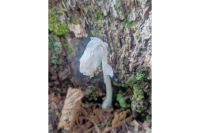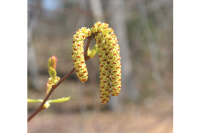Cherokee-run welfare office provides easier access to aid
 From the outside, Sandy Cloer’s office doesn’t look like much — not even a real office, in fact.
From the outside, Sandy Cloer’s office doesn’t look like much — not even a real office, in fact.
The three double-wide trailers strung end-to-end and plopped at the back of a barren parking lot hardly seem cut from the same cloth as Harrah’s Cherokee Casino and Resort just a few miles away, dripping with glitz and glam and money.
But both, in fact, tell the same story — the story of the Eastern Band of Cherokee Indians taking ownership for its own people. While the casino has lifted the economy of Cherokee as a whole, Cloer’s humble quarters in the tribe’s new welfare office marks yet another step on the trajectory of self-determination.
This year, the tribe took over federal welfare assistance for tribal members. Before, tribal members had to apply for assistance through social service agencies in neighboring counties. Now, needy tribal members can apply for help directly through their own tribe-run program.
“A lot of elders in the tribe don’t want to go off the reservation for services. They just don’t. It is a cultural thing. A lot of folks are too proud to do that,” Cloer said.
Related Items
The tribe believes it can do a better job reaching its own tribal members in need. Indeed, the number of enrolled members tapping the federal assistance has tripled now that it is operated by the tribe and housed in an office on the reservation.
In December, the month before the tribe took over the program, only 12 enrolled members received assistance. This month, there were 35.
Federal welfare dollars usually flow from the federal government to the state and then to counties. The reservation spans parts of five counties. So the tribe’s share of dollars — about $800,000 — was divvied up to the different counties that claim a portion of the reservation.
But some in Cherokee believe tribal members weren’t getting their fair share of assistance.
“It was not coming to the reservation,” said Cherokee Tribal Court Justice Bill Boyum.
Reasons were varied.
For starters, some tribal members simply didn’t know about the financial assistance. The outreach by county social service agencies on the reservation was “inadequate” in Boyum’s book.
“Nobody really knew about it,” Boyum said.
But there were also cultural barriers.
“People are more comfortable going in to an office in Cherokee rather than over to Bryson City,” said Boyum.
Whether tribal members were getting their fair share of welfare assistance is unclear. Before the tribe took over the operations, the state was unable to provide hard numbers of exactly how much of the money earmarked for the reservation was actually going to enrolled members.
Regardless, the biggest barrier had nothing to do with the neighboring counties themselves.
Most tribal members simply didn’t qualify for federal welfare assistance because they didn’t meet the poverty criteria, according to Shelia Sutton, interim director of Swain DSS.
Tribal members get a cut of casino profits. It currently amounts to about $8,000 a year. That small amount was enough to push tribal members above the income threshold to qualify for assistance.
As a result, neighboring counties often didn’t spend the entire pot designated for tribal members on tribal members — simply because they weren’t eligible. And if it wasn’t all used, the county social services departments could put it toward other things.
Now that the tribe is running its own program, however, it has flexibility to craft its own income criteria.
“The biggest benefit for the tribe taking over is the tribe can set its own eligibility requirements,” Boyum said. “The tribe has made a larger population eligible.”
Only 60 out of more than 300 federally recognized tribes run their own federal welfare programs.
More tribes are interested in going that route, however.
“There is flexibility to design your own program that makes sense for your community,” said Felicia Gaither, director of the federal program for tribes. “There is a benefit to serving the community where the tribal leadership understands what the challenges may be.”
A safety net
What was once known as simply “welfare” has many different names and many different funding pieces these days. There’s money to help grandparents or relatives raising children who aren’t their own. There’s help for the struggling, minimum-wage work class that has no cushion to absorb life’s curve balls.
“So many people live from paycheck to paycheck and one setback can throw them off,” Boyum said.
Say your car breaks down and you don’t have the money to fix it, but without your car you lose your job. The assistance can help with one-time car repairs.
“Hopefully we can help people get over the hump,” Cloer said.
Or perhaps they lack the upfront deposit for utility hookups.
“They have enough money to get by but not for a deposit,” Boyum said.
Another part of the program is crisis and emergency assistance. Cloer has a stash of grocery store gift cards and gas gift cards, and even boxes of food, they can hand out.
There’s also the classic welfare payments. Those who simply don’t make enough to get by can apply for a monthly living stipend. The catch these days is that it’s temporary, however.
Welfare assistance is capped at a maximum of five years over someone’s lifetime. The limited duration is supposed to keep generation after generation from living on handouts and instead help them get into the workforce through job training. They also get basic life-skills coaching, including household budgeting.
Known these days as Work First instead of welfare, anyone receiving assistance also has to prove they are looking for a job. The requirements often deter applicants who simply don’t want to jump through those hoops, Cloer said.
Grandparents raising grandchildren
One of the biggest needs in Cherokee is assistance for grandparents or other relatives struggling to raise children who aren’t their own.
“That was one of the things we wanted to target because we felt like that was a huge need,” Cloer said.
Parents off-load their children with a relative for a number of reasons. The most common: the parents are teens, are using drugs, are in jail or are still in school. It poses a financial burden on whoever takes them in.
“You can spend $50 a month on diapers,” Cloer said.
But there is a barrier keeping many grandparents from tapping the monetary assistance. If they apply for help, it automatically triggers a child support case against the child’s parents, Cloer said.
Grandparents are often reluctant to apply if it means their own son or daughter will be handed a child support bill.
The grandparents also fear the parents will just show up and take their grandchild back rather than pay the child support.
“A lot of times the grandparents don’t want the children to be taken back because they know they aren’t going to be cared for,” Cloer said. “It’s an emotional issue.”
At the same time, it’s only fair that the parent should be pitching in financially for the cost of feeding and clothing their children left in a relative’s care.
“If parents were paying child support, the grandparents wouldn’t need assistance,” Cloer said. “If the daughter or son doesn’t have any money, then why aren’t they working? The fact they don’t have a job or aren’t doing anything right now, that’s just not good enough.”
Cloer isn’t Cherokee herself. But she has worked intimately with the tribe for 17 years in child support before overseeing the new tribal welfare program.
Cloer has seen the benefits of the tribe taking ownership of social services once before — namely in the child support arena. Collecting child support used to be state-run operation. Cloer was based out of an office in nearby Bryson City, even though she oversaw child support collection on the reservation.
Then the tribe took over its own child support in 2010. Since then, collections have risen from $2.4 million a year to $3 million a year.
“Mainly we think it has been the accessibility of being here on the reservation. A lot of enrolled members don’t like to travel off the reservation for services,” Cloer said.
The tribe actually has the highest child support collection rate in the state — thanks in large part to the ability to garnish the annual casino dividends of tribal members who owe child support.
Building a brand new social welfare department wasn’t easy. It took a year of planning and training to get the tribally-run program off the ground.
“We had to put policies and procedures in place, had to hire staff, had to have a building to put people in,” said Cloer.
The welfare assistance office has three employees in Cherokee, and a fourth stationed in Snowbird, a satellite area of the reservation in rural Graham County.
Budget trails
When the tribe took over its own welfare program, money that was once funneled to the state and then to counties to serve tribal members started going directly to the tribe instead.
The federal government subtracted Cherokee’s share from what it gave the state.
The state then lopped Cherokee’s share off the top of its overall welfare budget, reducing the amount for every county in the state by a little, according to Ricky Diaz, spokesperson for the N.C. Department of Health and Human Services.
Presumably, the counties neighboring Cherokee won’t have as many people to serve now that tribal members can go through their own tribal program.
But instead of selectively cutting the welfare budget for those counties, the state spread the cuts across all 100 counties.
In the scheme of things, Cherokee’s share of welfare dollars is only a small slice of the state’s total allocation. Cherokee accounts for less than 0.3 percent — or one-third of one percent — of the state’s federal welfare dollars. The state gets $304 million from the federal government. Of that, $804,000 was deemed Cherokee’s share.
It was certainly easier to lop that $804,000 off the top of the state’s whole budget instead of taking it solely away from the counties in and around Cherokee itself.
But simplicity alone wasn’t the reason for the state’s approach. Technically, tribal members could still go through neighboring counties to apply for assistance.
“In fact we still have them coming here for Work First stuff,” said Shelia Sutton, interim director of Swain DSS. “We can’t deny or discourage anybody from applying. If they prefer to come here, we will process their application.”
But that also gives rise to another hidden problem.
“We have a lot of communication that has to go on to make sure people don’t double dip,” Sutton said.
When an enrolled member applies through the Swain welfare office, Sutton said they call the tribe’s office to make sure the applicant hasn’t gone there as well.
“It is going to hinge on a lot of communications that we don’t overspend our dollars,” Sutton said.
The tribe’s share of welfare funding — $804,000 — was apparently calculated at the state level.
“Our figures came from what the state submitted on what they would have spent on Native families in those service areas,” said Felicia Gaither, director of the federal program for tribes.
But the state Department of Health and Human Services was unable to quantify how much assistance went to tribal members over the course of a year before the tribe took over the program.
But from the tribe’s perspective, they feel like enrolled members have more at their disposal now that the dollars are in their control.
Regardless, Cloer has no doubt it will all be used.
“We are worried about running out at the rate we are going right now,” Cloer said.













